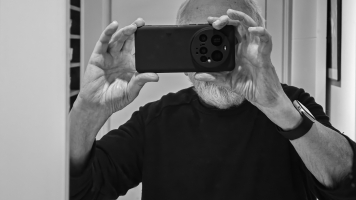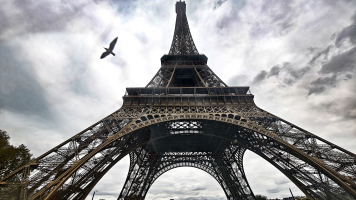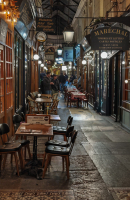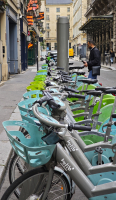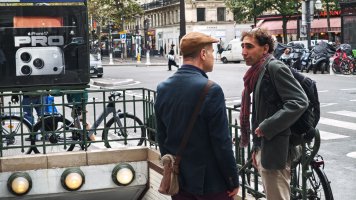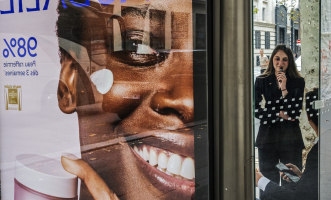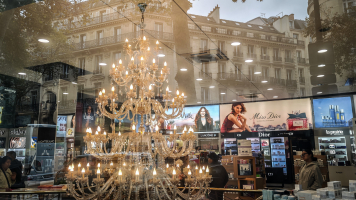Blick auf die riesige und dennoch so leicht wirkende George Washington Bridge vom Hudson River aus
English translation following this story
Eine Bilder-Galerie zu diesem Thema finden Sie HIER
Rund 20 Brücken unterschiedlicher Bauart und unterschiedlichen Tragvermögens verbinden die Insel Manhatten, das heftig schlagende Herz von New York City, mit dem umgebenden Festland. Die meisten dieser Bauwerke gelten bis heute als Denkmäler genialer und vorausschauender Baukunst.
Nicht nur seine Skyline mit immer mehr und immer höheren Wolkenratzern hat Manhattan berühmt gemacht. Auch seine Brücken sind bis heute eine Touristenattraktion. Sie entstanden überwiegend im vorletzten Jahrhundert, als an motorisierten Verkehr doch noch gar nicht zu denken war. Größenwahn oder weise Voraussicht?? Heute fahren täglich bis zu 1,8 Millionen Fahrzeuge über Manhattans Brücken. Den besten Blick auf sie hat man vermutlich von einer der Fähren, die von Reiseunternehmen angeboten werden, und die täglich mehrmals rund um die Insel fahren. Ich habe die meisten dieser beeindruckenden Bauwerke vor wenigen Jahren fotografiert. Sie sind ein MUSS für jeden New York Touristen.
NYC’s Brooklyn Bridge 1870 – 1883 für damals 15 Millionen Dollar erbaut
Brooklyn-Bridge: Stabil genug für Elefanten
Die südlichste der 4 gewaltigen Brücken über den East River wurde im Jahr 1870 begonnen, doch erst 30 Jahre später fuhren die ersten motorisierten Wagen über sie vom südlichen Manhatten nach Brooklyn, das damals noch eine unabhängige Stadt war. Zur Zeit ihrer Eröffnung 1883 war sie die längste Hängebrücke der Welt. So lang war dieses Bauwerk, dass ihre Belastbarkeit öffentlich angezweifelt wurde. Um zu beweisen, dass die Brücke sicher war, führte ein Zirkusveranstalter eine Herde aus 21 Elefanten über sie. Heute wird die Brooklyn Bridge als eine der großartigsten Ingenieurleistungen des 19. Jahrhunderts anerkannt.
Warum aber ließen die Stadtvater Manhattans überhaupt um diese Zeit Brücken solcher Ausmaße bauen, die im wesentlichen viele Jahre lang doch nur von Pferdefuhrwerken und Straßenbahnen genutzt werden konnten? Immerhin kostete die Brooklyn Bridge damals rund 15 Millionen Dollar, das wären heute Inflations-bereinigt 400 Millionen USD.
Gewaltige Stahlseile und Netze tragen die Brooklyn Bridge
Urbanisierung und wirtschaftliche Notwendigkeit
Warum aber ließen die Stadtväter Manhattans in diesen frühen Jahren derart monumentale Brücken über East River und Hudson sowie den quer-verbindenden Harlem River bauen? Gerade im späteren 19. Jahrhundert wuchs New York City rasant. Manhattan war zwar das wirtschatliche Zentrum, aber der Platz für die Besiedlung war begrenzt. Immer mehr Menschen wanderten ein, fanden hier Arbeit, lebten aber in Brooklyn, Queens und anderen Stadtteilen. Doch das einzige Verkehrsmittel zur Arbeit waren die langsamen, ständig überfüllten und Wetter-abhängigen Fähren über den East River. Im Winter blockierten Eisschollen den Fluss, im Sommer behinderten Stürme den Fährbetrieb.
Moderne Technik fördert Gigantomanie
Dass die Brücken derartig gewaltige Ausmaße erhielten, dass sie auch heute noch den täglichen Massenverkehr bewältigen, lag auch an den rasanten technischen Entwicklungen des späteren 19. Jahrhunderts. So ermöglichten neue Baumethoden (Stahlseile, Pressluftfundamente) große Spannweiten. So wurde die Brooklyn Bridge die erste Hängebrücke mit Stahlseilen. Doch auch der glühende Nationalismus in den schnell wachsenden Vereinigten Staaten war ein Antrieb für die architektonische Gigantomanie. New Yorks Ingenieure wollten der Welt beweisen, was sie alles mit der neuen Technik erreichen konnten. Die gigantische Brücken wurden zum Sinnbild des Fortschritts. New York City wuchs zum Zentrum der Weltwirtschaft, und ein schneller, zuverlässiger Warentransport war entscheidend für Handel, Märkte, Industrie. Die Brücken ermöglichten den direkte Handel zwischen den Stadtteilen und die schnelle Versorgung des Zentrums.
Manhattan Bridge: Klassische Hängebrücke im zeitgemäßen Beaux Arts-Stil
Manhattan Bridge: Modernes Design und kürzere Bauzeit
30 Jahre nach der Brooklyn Bridge begann die Stadt (1901) mit dem Bau der benachbarten Manhattan Bridge durch die Architekten Carrère and Hastings. Auch dieses Bauwerk war “State of the Art” durch die Verwendung neuester Technologien. Optisch wirkte sie durch die Verwendung neuerer Materialien und die Anwendung stilistischer Elemente der Zeit (Beaux-Arts-Stil) deutlich leichter als die Nachbar-Brücke. Gleichzeitig wurde die Bauzeit deutlich verkürzt. Deshalb konnte sie schon 1909 eröffnet werden. Technisch gesehen ist die Manhattan Bridge eine klassische Hängebrücke und unterscheidet sich deshalb deutlich von ihrer deutlich massiger wirkenden älteren Schwester.
“hässlich aber funktional”? – Die Williamsburg-Bridge
Williamsburg Bridge – Fast alles aus Stahl, aber auch schön?
Etwas früher als ihre schlank und elegant wirkende Schwester, die Manhattan-Bridge, wurde die weiter nördlich liegende Williamsburg Bridge über den East River eröffnet (1903 – Bauzeit sieben Jahre). Doch auch dieses – überwiegend aus Stahl gefertigte Bauwerk war natürlich für die damaligen verkehrstechnischen Anforderungen zunächst völlig überdimensioniert. Tatsächlich wirkt die Brücke auf den ersten Blick eher wie ein Werk aus einem klassischen Metallbaukasten. Und dennoch tut sie nach einr aufwändigen Restaurierung um die Jahrtausendwende trotz ihres Rufs als “hässlich aber funktional” bis heute ihren Dienst als Verbindung zwischen der Lower East Side von Manhattan und dem Stadtteil Williamsburg in Brooklyn.
Immerhin: Die Williamsburg Bridge war bei der Eröffnung die längste Hängebrücke der Welt mit einer Länge von etwa 2230 Metern, einer Breite von 36 Metern und einer Spannweite von knapp 500 Metern. Die Baukosten lagen bei ca 12 Millionen Dollar oder 400-500 Millionen Dollar nach heutigem Kurs. Ursprünglich war sie vor allem für Fußgänger, Pferdewagen, Straßenbahnen und die Eisenbahn gedacht. Inzwischen ist die Fahrbahn auf insgesamt 8 Spuren für Autos ausgebaut, besitzt Fuß- und Radwege und wird von 3 U-Bahnlinien genutzt. Wer die U-Bahn heute noch benutzt, der versteht, dass diese Brücke die Entwicklung des Stadtteils Williamsburg als Arbeiterviertel entscheidend mitgeprägt hat
Wie eingebaut: Die Queensboro-Bridge
Die ganz besondere: Queensboro-Bridge
Die Queensboro Bridge ist die letzte der vier großen, aber auch eine der wichtigsten Brücken über den East River. Sie befindet sich weiter nördlich als die vorherigen drei Brücken und verbindet die Upper East Side Manhattans mit der Long Island City in Queens. Sie verläuft auch über Roosevelt Island. Der offizielle Name der Brücke ist heute “Ed Koch Queensboro Bridge”, aber sie wird auch 59th Street Bridge genannt, aufgrund ihres Anfangspunkts in dicht bebautem Gebiet auf der Manhattan Seite. Die Auslegerbrücke wurde von 1901 bis 1909 erbaut und besitzt mehrere Fahrbahnen, einen Fußweg und einen Radweg. Außerdem gibt es eine Drahtseilbahn, die parallel zur Nordseite der Brücke verläuft und Passagiere von Manhattan zur Roosevelt Island bringt. Die Baukosten lagen nach heutigem Wert zwischen 500-600 Millionen Dollar.
Queensboro Bridge ist allein schon bautechnisch eine Besonderheit, denn sie wurde trotz ihrer großen Länge von 2270 Metern als Auslegerbrücke konzipiert. Das heißt, dass die Fahrbahnen nur von langen, massiven Stahlträgern gehalten werden und damit über eine Länge von 360 Metern keinen Stützpfeiler brauchen. Heute umfasst die Brücke 10 Fahrbahnen und natürlich Fuß und Radwege. Das besondere an der Queensboro Bridge ist die Roosevelt Island Tramway, die direkt neben der Brücke verläuft und Roosevelt Island mit Manhattan verbindet. Berühmt wurde die Brücke aus Filmen wie “Spider Man” oder auch durch den Song „The 59th Street Bridge Song (Feelin’ Groovy)“ von Simon & Garfunkel. Die stark frequentierte und Maut-freie Brücke wird bis heute sehr stark von den Pendlern aus Queens genutzt. sie ist zwar alles andere als elegant gilt aber bei Experten als “echtes Arbeitstier der Stadt, funktional, urban und langlebig”.
Die High Bridge ist die älteste Brücke von NYC aus dem Jahr 1848
Die Spuyten Duyvil Bridge. Eine Drehbrücke aus dem Jahr 1900
Erläuterungen zu den anderen hier genannten Brücken finden Sie unter den einzelnen Bildern in der Galerie (Robert F. Kennedy, High Bridge, University Heights Bridge, Broadway Bridge, Spuyten Duyvil Bridge, Henry Hudson Brdge und George Washingon Bridge)
Die vermutlich wichtigste: George Washington Bridge
George Washington Bridge – 100 Million Fahrzeuge im Jahr
Die 1931 eröffnete George Washington Bridge über den Hudson ist nicht nur die wichtigste Brücke von Manhatten aufs Festland (New Jersey), sie ist auch eine der bedeutendsten Brücken in den USA – sowohl verkehrstechnisch als auch symbolisch. Das vom Schweiz-stämmigen Architekten Othmar Amman entworfene Bauwerk ist allein schon deshalb so bedeutsam, weil zuletzt 1962 eine zweite Ebene (Doppelstockbrücke) hinzugefügt wurde. Sie gilt als zentraler Knotenpunkt für den Güterverkehr zwischen New York und dem gesamten Nordosten der USA und ist mit rund 100 Millionen Fahrzeugen eine der meist befahrenen Brücken der Welt. Mit einer Spannweite der Hauptöffnung von etwa 1100 Metern war sie zum Zeitpunkt ihrer Fertigstellung die längste Hängebrücke der Welt (allerdings nur bis zur Eröffnung der Golden Gate Bridge in Kalifornien)
Übrigens (und nur mal zwischendurch):
Der East River ist eigentlich kein echter Fluss, sondern lediglich eine sogenannte Gezeitenstraße, das heißt, das Wasser, das den Fluss speist, strömt aus dem benachbarten Meer. Abhängig von dessen Gezeiten ändert sich der Wasserfluss mehrmals täglich entsprechend nach Norden oder nach Süden. Auch der Harlem River , der East River und Hudson verbindet, ist nicht wirklich ein River/Fluss, sondern ein schmaler Kanalarm. Lediglich der Hudson ist ein Strom, der csstaat New Jersey von NYC trennte.
Hier nun die Namen der verschiedenen Brücken über East River, Harlem River und den Hudson, wie sie von ChatGPT (jeweils von Süden nach Norden) zusammengestellt wurden:
East River (Verbindung zwischen Manhattan, Brooklyn und Queens) (nur die ersten sechs wirklich bedeutend)
| Nr. | Name der Brücke | Baujahr | Verbindung |
|---|---|---|---|
| 1 | Brooklyn Bridge | 1883 | Manhattan ↔ Brooklyn |
| 2 | Manhattan Bridge | 1909 | Manhattan ↔ Brooklyn |
| 3 | Williamsburg Bridge | 1903 | Manhattan ↔ Brooklyn |
| 4 | Queensboro Bridge (59th St / Ed Koch) | 1909 | Manhattan ↔ Queens |
| 5 | Roosevelt Island Bridge | 1955 | Queens ↔ Roosevelt Island |
| 6 | Robert F. Kennedy (Triborough Bridge) | 1936 | Manhattan ↔ Queens ↔ Bronx (über Randalls Island) |
| 7 | Hell Gate Bridge | 1916 | Queens ↔ Bronx (nur Eisenbahn) |
| 8 | Throgs Neck Bridge | 1961 | Queens ↔ Bronx |
| 9 | Whitestone Bridge | 1939 | Queens ↔ Bronx |
Brücken über den Harlem River (Verbindung zwischen Manhattan und der Bronx)
| Nr. | Name der Brücke | Baujahr | Typ / Info |
|---|---|---|---|
| 1 | Third Avenue Bridge | 1898 (aktuelle Version: 2005) | Einbahnbrücke Bronx → Manhattan |
| 2 | Willis Avenue Bridge | 1901 (neu: 2010) | Einbahnbrücke Manhattan → Bronx |
| 3 | 145th Street Bridge | 1905 | Drehbrücke |
| 4 | Madison Avenue Bridge | 1910 | Drehbrücke |
| 5 | Macombs Dam Bridge | 1895 | Historische Drehbrücke |
| 6 | 145th Street Bridge | 1905 | Wiederholung (oft verwechselt) |
| 7 | High Bridge | 1848 (Fußgängerbrücke seit 2015) | Älteste Brücke NYC – ehem. Aquädukt |
| 8 | Washington Bridge | 1888 | Wichtige Verkehrsbrücke |
| 9 | Alexander Hamilton Bridge | 1963 | Teil der I-95 / Cross-Bronx Expressway |
| 10 | Harlem River Lift Bridge | 1956 | Eisenbahnbrücke (Metro-North) |
| 11 | Broadway Bridge | 1962 (heutige Version) | Zug + Straße (über Spuyten Duyvil Creek) |
Brücken über den Hudson (Verbindung zwischen Manhattan / Bronx und New Jersey)
| Nr. | Name der Brücke | Baujahr | Verbindung |
|---|---|---|---|
| 1 | George Washington Bridge | 1931 | Manhattan ↔ Fort Lee, New Jersey |
| 2 | Henry Hudson Bridge | 1936 | Bronx ↔ Spuyten Duyvil / NJ |
| – | (Tunnel als Ergänzung: Holland Tunnel, Lincoln Tunnel) | – | – |
English translation:
You can find a picture gallery on this topic HERE
Around 20 bridges of various designs and load capacities connect Manhattan Island, the beating heart of New York City, with the surrounding mainland. Most of these structures are still considered monuments to ingenious and forward-thinking engineering.
It is not only its skyline with its ever-increasing number of skyscrapers that has made Manhattan famous. Its bridges are also a tourist attraction to this day. Most of them were built in the 19th century, when motorised traffic was still unthinkable. Megalomania or wise foresight? Today, up to 1.8 million vehicles cross Manhattan’s bridges every day. The best view of them is probably from one of the ferries offered by travel companies, which run several times a day around the island. I photographed most of these impressive structures a few years ago. They are a MUST for every New York tourist.
NYC’s Brooklyn Bridge 1870 – 1883, built for 15 million dollars at the time
Brooklyn Bridge: Strong enough for elephants
The southernmost of the four enormous bridges over the East River was begun in 1870, but it was not until 30 years later that the first motorised cars drove across it from southern Manhattan to Brooklyn, which was then still an independent city. When it opened in 1883, it was the longest suspension bridge in the world. The structure was so long that its load-bearing capacity was publicly questioned. To prove that the bridge was safe, a circus organiser led a herd of 21 elephants across it. Today, the Brooklyn Bridge is recognised as one of the greatest engineering achievements of the 19th century.
But why did Manhattan’s city fathers decide to build bridges of such dimensions at that time, when they would essentially only be used by horse-drawn carriages and trams for many years? After all, the Brooklyn Bridge cost around 15 million dollars at the time, which would be 400 million dollars today after adjusting for inflation.
Huge steel cables and nets support the Brooklyn Bridge
Urbanisation and economic necessity
But why did Manhattan’s city fathers build such monumental bridges over the East River and Hudson River, as well as the Harlem River connecting them, in those early years? New York City grew rapidly, especially in the late 19th century. Manhattan was the economic centre, but space for settlement was limited. More and more people immigrated, found work here, but lived in Brooklyn, Queens and other neighbourhoods. However, the only means of transport to work were the slow, constantly overcrowded and weather-dependent ferries across the East River. In winter, ice floes blocked the river, and in summer, storms hampered ferry operations.
Modern technology promotes gigantomania
The fact that the bridges were built on such a grand scale that they can still handle daily mass traffic today was also due to the rapid technological developments of the late 19th century. New construction methods (steel cables, compressed air foundations) enabled large spans. The Brooklyn Bridge became the first suspension bridge with steel cables. But the fervent nationalism in the rapidly growing United States was also a driving force behind architectural gigantomania. New York’s engineers wanted to prove to the world what they could achieve with the new technology. The gigantic bridges became a symbol of progress. New York City grew to become the centre of the global economy, and fast, reliable transport of goods was crucial for trade, markets and industry. The bridges enabled direct trade between the city’s districts and rapid supply of the centre.
Manhattan Bridge: Classic suspension bridge in the contemporary Beaux Arts style
Manhattan Bridge: Modern design and shorter construction time
Thirty years after the Brooklyn Bridge, the city began construction of the neighbouring Manhattan Bridge in 1901, designed by architects Carrère and Hastings. This structure was also state of the art, incorporating the latest technologies. The use of newer materials and stylistic elements of the time (Beaux Arts style) made it appear much lighter than its neighbour. At the same time, the construction time was significantly reduced. As a result, it was opened in 1909. Technically speaking, the Manhattan Bridge is a classic suspension bridge and therefore differs significantly from its older sister, which appears much more massive.
‘Ugly but functional’? – The Williamsburg Bridge
Williamsburg Bridge – Almost entirely made of steel, but also beautiful?
A little earlier than its slender and elegant sister, the Manhattan Bridge, the Williamsburg Bridge, located further north, was opened over the East River (1903 – construction time seven years). However, this structure, which was also made predominantly of steel, was of course completely oversized for the traffic requirements of the time. At first glance, the bridge actually looks more like a classic metal construction kit. And yet, despite its reputation as ‘ugly but functional’, it continues to serve as a link between Manhattan’s Lower East Side and the Williamsburg district of Brooklyn to this day, following extensive restoration work at the turn of the millennium.
After all, when it opened, the Williamsburg Bridge was the longest suspension bridge in the world, with a length of approximately 2,230 metres, a width of 36 metres and a span of almost 500 metres. The construction costs amounted to approximately 12 million dollars, or 400-500 million dollars at today’s exchange rate. It was originally intended primarily for pedestrians, horse-drawn carriages, trams and the railway. The carriageway has since been expanded to a total of eight lanes for cars, has footpaths and cycle paths, and is used by three underground lines. Anyone who still uses the underground today understands that this bridge has played a decisive role in shaping the development of Williamsburg as a working-class district.
Built-in: The Queensboro Bridge
The very special Queensboro Bridge
The Queensboro Bridge is the last of the four large bridges over the East River and also one of the most important. It is located further north than the previous three bridges and connects Manhattan’s Upper East Side with Long Island City in Queens. It also runs over Roosevelt Island.
The official name of the bridge today is ‘Ed Koch Queensboro Bridge,’ but it is also called the 59th Street Bridge because of its starting point in a densely built-up area on the Manhattan side. The cantilever bridge was built between 1901 and 1909 and has several lanes, a footpath and a cycle path. There is also a cable car that runs parallel to the north side of the bridge, taking passengers from Manhattan to Roosevelt Island. The construction costs were between 500 and 600 million dollars in today’s money.
The Queensboro Bridge is a special feature in terms of its construction alone, as it was designed as a cantilever bridge despite its considerable length of 2,270 metres. This means that the roadways are supported only by long, solid steel girders and therefore do not require any support pillars over a length of 360 metres. Today, the bridge has 10 lanes and, of course, footpaths and cycle paths. A special feature of the Queensboro Bridge is the Roosevelt Island Tramway, which runs directly next to the bridge and connects Roosevelt Island with Manhattan. The bridge became famous in films such as Spider-Man and through the song ‘The 59th Street Bridge Song (Feelin’ Groovy)’ by Simon & Garfunkel. The busy, toll-free bridge is still heavily used by commuters from Queens today. Although it is anything but elegant, experts consider it a ‘real workhorse of the city, functional, urban and durable’.
The High Bridge is the oldest bridge in NYC, dating back to 1848.
The Spuyten Duyvil Bridge. A swing bridge dating from 1900
Explanations of the other bridges mentioned here can be found under the individual images in the gallery (Robert F. Kennedy, High Bridge, University Heights Bridge, Broadway Bridge, Spuyten Duyvil Bridge, Henry Hudson Bridge and George Washington Bridge).
Probably the most important: George Washington Bridge
George Washington Bridge – 100 million vehicles per year
Opened in 1931, the George Washington Bridge over the Hudson River is not only the most important bridge connecting Manhattan to the mainland (New Jersey), it is also one of the most significant bridges in the United States – both in terms of traffic and symbolism. Designed by Swiss-born architect Othmar Ammann, the structure is significant in its own right, not least because a second level (double-deck bridge) was added in 1962. It is considered a central hub for freight traffic between New York and the entire north-east of the USA and, with around 100 million vehicles, is one of the busiest bridges in the world. With a main span of approximately 1,100 metres, it was the longest suspension bridge in the world at the time of its completion (although this record was short-lived, as it was surpassed by the Golden Gate Bridge in California).
Incidentally (and just as a side note):
The East River is not actually a real river, but merely a tidal strait, which means that the water that feeds the river flows from the neighbouring sea. Depending on the tides, the water flow changes several times a day, flowing north or south accordingly. The Harlem River, which connects the East River and the Hudson, is not really a river either, but a narrow canal arm. Only the Hudson is a river that separates New Jersey from NYC.
Here are the names of the various bridges over the East River, Harlem River and Hudson River, as compiled by ChatGPT (from south to north):
East River (connection between Manhattan, Brooklyn and Queens) (only the first six are really significant)
No. Name of bridge Year built Connection
1 Brooklyn Bridge 1883 Manhattan ↔ Brooklyn
2 Manhattan Bridge 1909 Manhattan ↔ Brooklyn
3 Williamsburg Bridge 1903 Manhattan ↔ Brooklyn
4 Queensboro Bridge (59th St / Ed Koch) 1909 Manhattan ↔ Queens
5 Roosevelt Island Bridge 1955 Queens ↔ Roosevelt Island
6 Robert F. Kennedy (Triborough Bridge) 1936 Manhattan ↔ Queens ↔ Bronx (via Randalls Island)
7 Hell Gate Bridge 1916 Queens ↔ Bronx (railway only)
8 Throgs Neck Bridge 1961 Queens ↔ Bronx
9 Whitestone Bridge 1939 Queens ↔ Bronx
Bridges over the Harlem River (connection between Manhattan and the Bronx)
No. Name of bridge Year built Type / Info
1 Third Avenue Bridge 1898 (current version: 2005) One-way bridge Bronx → Manhattan
2 Willis Avenue Bridge 1901 (new: 2010) One-way bridge Manhattan → Bronx
3 145th Street Bridge 1905 Swing bridge
4 Madison Avenue Bridge 1910 Swing bridge
5 Macombs Dam Bridge 1895 Historic swing bridge
6 145th Street Bridge 1905 Repeat (often confused)
7 High Bridge 1848 (pedestrian bridge since 2015) Oldest bridge in NYC – former aqueduct
8 Washington Bridge 1888 Important traffic bridge
9 Alexander Hamilton Bridge 1963 Part of the I-95 / Cross-Bronx Expressway
10 Harlem River Lift Bridge 1956 Railway bridge (Metro-North)
11 Broadway Bridge 1962 (current version) Train + road (over Spuyten Duyvil Creek)
Bridges over the Hudson (connection between Manhattan / Bronx and New Jersey)
No. Name of bridge Year built Connection
1 George Washington Bridge 1931 Manhattan ↔ Fort Lee, New Jersey
2 Henry Hudson Bridge 1936 Bronx ↔ Spuyten Duyvil / NJ










